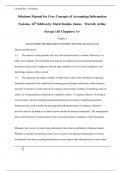Exam (elaborations)
Solutions Manual for Core Concepts of Accounting Information Systems, 14th Edition by Mark Simkin, James Worrell, Arline Savage (All Chapters) A+
- Course
- Institution
Solutions Manual for Core Concepts of Accounting Information Systems, 14th Edition by Mark Simkin, James Worrell, Arline Savage (All Chapters) A+..
[Show more]



